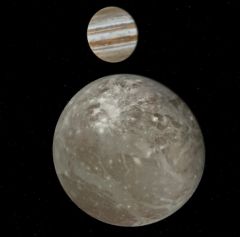Difference between revisions of "Ganymede"
Jump to navigation
Jump to search
(Added Template:SolarSystem.) |
(Added template, content.) |
||
| Line 1: | Line 1: | ||
| − | Ganymede is one of [[Jupiter|Jupiter's]] four [[Galilean Moons]]. It is also the largest Natural Satellite in the Solar System. | + | {| cellpadding="2" cellspacing="0" style="margin:25px 0 0 10px; border:3px solid lightsteelblue;width:250px; font-size:90%; font-family:'Arial','Helvetica'; float: right; clear: right;"Template in Orbiter" |
| + | !bgcolor="lightsteelblue" colspan="2" align="center" |Ganymede | ||
| + | |- | ||
| + | |colspan="2" align="center"|[[Image:GanymedeScrshot.jpg|240px]] | ||
| + | |- | ||
| + | |colspan="2" align="center"|'''Ganymede in Orbiter 2016 with D3D9 client''' | ||
| + | |- | ||
| + | !bgcolor="lightsteelblue" colspan="2"|Designation | ||
| + | |- | ||
| + | |Name||align="right"|Ganymede | ||
| + | |- | ||
| + | |width="30%"|Reference body||align="right" width="30%"|Jupiter | ||
| + | |- | ||
| + | !bgcolor="lightsteelblue" colspan="2"|Planetary mean orbits | ||
| + | |- | ||
| + | |width="30%"|Epoch||align="right" width="50%"|J2000 (1 January 2000) | ||
| + | |- | ||
| + | |width="30%"|Semimajor axis (a)||align="right" width="50%"|1.0704×10<sup>9</sup> km | ||
| + | |- | ||
| + | |width="30%"|Eccentricity (e)||align="right" width="30%"|0.0016 | ||
| + | |- | ||
| + | |width="30%"|Inclination (i)||align="right" width="30%"|0.18598° <br> (0.003246 radian) | ||
| + | |- | ||
| + | |width="30%"|Longitude of the ascending node (LAN, ☊)||align="right" width="30%"| 119.8409983°<br> (2.09162 radian) | ||
| + | |- | ||
| + | |width="30%"|Longitude of periapsis (ϖ)||align="right" width="30%"|188.8297° <br> (3.2957 radian) | ||
| + | |- | ||
| + | |width="30%"|Mean longitude (L)||align="right" width="30%"|121.203492° <br> (2.1154 radian) | ||
| + | |- | ||
| + | !bgcolor="lightsteelblue" colspan="2"|Selected physical parameters | ||
| + | |- | ||
| + | |width="30%"|Mean radius||align="right" width="30%"|2634000 km | ||
| + | |- | ||
| + | |width="30%"|Mass||align="right" width="30%"|1.48×10<sup>23</sup> kg | ||
| + | |- | ||
| + | !bgcolor="lightsteelblue" colspan="2"|Rotation elements | ||
| + | |- | ||
| + | |width="30%"|SidRotPeriod||align="right" width="30%"|618192 seconds (7.155 hours) | ||
| + | |- | ||
| + | |width="30%"|SidRotOffset||align="right" width="30%"|0 | ||
| + | |- | ||
| + | |width="30%"|Obliqutiy||align="right" width="30%"|0 | ||
| + | |- | ||
| + | |width="30%"|LAN||align="right" width="30%"|0 | ||
| + | |- | ||
| + | |width="30%"|Note||align="right" width="30%"|*Elements given are from Ganymede.cfg (2002) | ||
| + | |} | ||
| + | |||
| + | '''Ganymede''' is one of [[Jupiter|Jupiter's]] four [[Galilean Moons]], the third from Jupiter. It is also the largest Natural Satellite in the Solar System and its diameter is larger than Mercury's by about 8%. | ||
[[Category: Celestial bodies]] | [[Category: Celestial bodies]] | ||
Revision as of 00:07, 12 July 2024
Ganymede is one of Jupiter's four Galilean Moons, the third from Jupiter. It is also the largest Natural Satellite in the Solar System and its diameter is larger than Mercury's by about 8%.
| edit The Solar System | |
|---|---|
| Central star |
Sun (Sol) |
| Planets |
Mercury - Venus - Earth - Mars - Jupiter - Saturn - Uranus - Neptune |
| Natural satellites |
Moon - Phobos - Deimos - Io - Europa - Ganymede - Titan - more... |
| Add-ons |
Planets - Dwarf Planets - Small objects - Natural satellites - Alternative star systems |
 | This natural satellite related article is a stub. You can help Orbiterwiki by expanding it.
|
